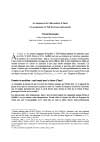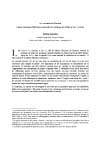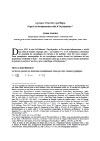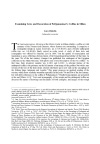XXVIe dynastie
« La demeure de Min maĂ®tre d’Imet. Un monument de Tell Farâoun rĂ©interprĂ©tĂ© »
ENiM 2, 2009, p. 103-108.
 Un nouvel examen de blocs de granite découverts à Tell Farâoun/Nebesheh par Petrie permet de préciser l’attribution du petit temple de l’ancienne ville d’Imet. Leur identification à deux montants de porte confirme la première impression que pouvait laisser la configuration des lieux, à savoir que le petit temple d’Imet ne serait pas la demeure de la déesse principale, Ouadjet dame d’Imet, mais celle de Min. L’époque à laquelle remonte ce temple, parfaitement daté par un dépôt de fondation du roi Amasis (XXVIe dyn.), correspond à celle où le dieu Min d’Imet apparaît dans la documentation.
Un nouvel examen de blocs de granite découverts à Tell Farâoun/Nebesheh par Petrie permet de préciser l’attribution du petit temple de l’ancienne ville d’Imet. Leur identification à deux montants de porte confirme la première impression que pouvait laisser la configuration des lieux, à savoir que le petit temple d’Imet ne serait pas la demeure de la déesse principale, Ouadjet dame d’Imet, mais celle de Min. L’époque à laquelle remonte ce temple, parfaitement daté par un dépôt de fondation du roi Amasis (XXVIe dyn.), correspond à celle où le dieu Min d’Imet apparaît dans la documentation.
 The reconsideration of granite fragments unearthed by Petrie at Tell Farʿun / Nebesheh allows us to clarify the attribution of the small temple of the ancient town of Imet. Their identification to two door-jambs confirms the first impression that could give the field, namely that the small temple is not the place of worship of Wadjet of Imet, the main deity, but the one of Min. The date of the construction of this temple, given by a foundation deposit of Amasis (26th dyn.), coincides with the date of the apparition of Min of Imet in the documentation.
The reconsideration of granite fragments unearthed by Petrie at Tell Farʿun / Nebesheh allows us to clarify the attribution of the small temple of the ancient town of Imet. Their identification to two door-jambs confirms the first impression that could give the field, namely that the small temple is not the place of worship of Wadjet of Imet, the main deity, but the one of Min. The date of the construction of this temple, given by a foundation deposit of Amasis (26th dyn.), coincides with the date of the apparition of Min of Imet in the documentation.
 Consulter cet article (45637) -
Consulter cet article (45637) -  Télécharger cet article au format pdf (24003)
Télécharger cet article au format pdf (24003)
« Le cercueil de Peniou. MusĂ©e national d’Histoire naturelle de Santiago du Chili (no inv. 11.160) »
ENiM 2, 2009, p. 109-128.
 L’analyse du cercueil de Pȝ-n(y)-jw (XXXe dyn. – dĂ©but de l’époque ptolĂ©maĂŻque ; MusĂ©e d’histoire naturelle de Santiago du Chili – MNHN 11.160) permet de mettre en lumière l’emploi d’une boiserie en trompe-l’œil originale et son rapport avec diffĂ©rents motifs religieux, notamment deux figures d’Anubis anthropomorphe adoptant la posture ksw.
L’analyse du cercueil de Pȝ-n(y)-jw (XXXe dyn. – dĂ©but de l’époque ptolĂ©maĂŻque ; MusĂ©e d’histoire naturelle de Santiago du Chili – MNHN 11.160) permet de mettre en lumière l’emploi d’une boiserie en trompe-l’œil originale et son rapport avec diffĂ©rents motifs religieux, notamment deux figures d’Anubis anthropomorphe adoptant la posture ksw.
 The analysis of the Pȝ-n(y)-jw’s coffin (Dynasty 30 – Ptolemaic Period; Museo Nacional de Historia Natural, Santiago of Chile – MNHN 11.160) allows to throw a light on the use of an original woodwork in trompe l’oeil and his relationship with various religious motives, specially two anthropomorphic Anubis in the ksw posture.
The analysis of the Pȝ-n(y)-jw’s coffin (Dynasty 30 – Ptolemaic Period; Museo Nacional de Historia Natural, Santiago of Chile – MNHN 11.160) allows to throw a light on the use of an original woodwork in trompe l’oeil and his relationship with various religious motives, specially two anthropomorphic Anubis in the ksw posture.
 Consulter cet article (54492) -
Consulter cet article (54492) -  Télécharger cet article au format pdf (25086)
Télécharger cet article au format pdf (25086)
« Ă€ propos d’un titre spĂ©cifique d’après la documentation saĂŻte d’Oxyrhynchos »
ENiM 8, 2015, p. 1-9.
 Identification du titre jmy-nww transmis par la documentation écrite issue des fouilles d’el-Bahnasa / Oxyrhynchos.
Identification du titre jmy-nww transmis par la documentation écrite issue des fouilles d’el-Bahnasa / Oxyrhynchos.
 Identification of the title jmy-nww transmitted by the written sources from excavations in el-Bahnasa / Oxyrhynchus.
Identification of the title jmy-nww transmitted by the written sources from excavations in el-Bahnasa / Oxyrhynchus.
 Consulter cet article (45110) -
Consulter cet article (45110) -  Télécharger cet article au format pdf (22621)
Télécharger cet article au format pdf (22621)
« Examining Texts and Decoration of Peftjauauiaset’s Coffins in Milan »
ENiM 11, 2018, p. 41-133.
 Cet article présente une étude des textes et de la décoration des cercueils de Peftjauauiaset au Musée Archéologique de Milan, datant de la XXVIe dynastie. Les séries de divinités peintes sur les trois côtés extérieurs du cercueil rectangulaire représentent les formes du dieu solaire dans le monde inférieur, au service du défunt avec leur protection, leurs provisions et leurs énergies vitales. La figure de Nout avec le corps tendu et les bras levés est représentée sur l’intérieur du couvercle du cercueil anthropoïde, entouré par les déesses du jour et de la nuit. Une version rare du rituel des heures, qui est comparé dans cet article à la version du Livre de la Nuit et du Livre du Jour inscrite dans la tombe de Ramsès VI, est particulièrement intéressante. La figure d’Amentet à l'intérieur de la valve inférieure est entourée d’un texte endommagé, contenant des références claires aux rituels d’Amon. Le programme décoratif et textuel des cercueils, avec les formes du dieu solaire, le rituel des heures destiné à la protection et à la régénération solaire du cadavre d’Osiris pendant le jour et la nuit, et le texte comparant le défunt à Amon, expriment des concepts théologiques attestés dans la décoration des monuments funéraires de la période koushite-saïte, et représentent un remarquable exemple d’innovation au sein de la tradition, dans une période de grands changements politiques.
Cet article présente une étude des textes et de la décoration des cercueils de Peftjauauiaset au Musée Archéologique de Milan, datant de la XXVIe dynastie. Les séries de divinités peintes sur les trois côtés extérieurs du cercueil rectangulaire représentent les formes du dieu solaire dans le monde inférieur, au service du défunt avec leur protection, leurs provisions et leurs énergies vitales. La figure de Nout avec le corps tendu et les bras levés est représentée sur l’intérieur du couvercle du cercueil anthropoïde, entouré par les déesses du jour et de la nuit. Une version rare du rituel des heures, qui est comparé dans cet article à la version du Livre de la Nuit et du Livre du Jour inscrite dans la tombe de Ramsès VI, est particulièrement intéressante. La figure d’Amentet à l'intérieur de la valve inférieure est entourée d’un texte endommagé, contenant des références claires aux rituels d’Amon. Le programme décoratif et textuel des cercueils, avec les formes du dieu solaire, le rituel des heures destiné à la protection et à la régénération solaire du cadavre d’Osiris pendant le jour et la nuit, et le texte comparant le défunt à Amon, expriment des concepts théologiques attestés dans la décoration des monuments funéraires de la période koushite-saïte, et représentent un remarquable exemple d’innovation au sein de la tradition, dans une période de grands changements politiques.
 This paper presents a study of texts and decoration in the coffins of Peftjauauiaset in the Archaeological Museum in Milan, dating to the Twenty-sixth Dynasty. Rows of deities depicted on three outer sides of the rectangular trough represent forms of the sun god in the netherworld, at the service of the deceased with their protection, provisions, and vital energies. The figure of Nut with outstretched body and upraised arms is depicted on the lid interior of the anthropoid coffin, surrounded by the goddesses of day and night. Of particular interest is a rare version of the hour ritual, which in this article is compared with the version of the Book of Night and Book of Day inscribed in the tomb of Ramses VI. The figure of Amentet on the interior of the lower valve is surrounded by a damaged text, containing clear references to Amun rituals. The decorative and textual program of the coffins, with the forms of the sun god on the rectangular through, the hour ritual destined to the protection and solar regeneration of the corpse of Osiris during the day and night, and the text paralleling the deceased to Amun, express theological concepts attested in the decoration of funerary monuments of the Kushite-Saite Period, and represent a remarkable example of innovation within the tradition, in a period of major political changes.
This paper presents a study of texts and decoration in the coffins of Peftjauauiaset in the Archaeological Museum in Milan, dating to the Twenty-sixth Dynasty. Rows of deities depicted on three outer sides of the rectangular trough represent forms of the sun god in the netherworld, at the service of the deceased with their protection, provisions, and vital energies. The figure of Nut with outstretched body and upraised arms is depicted on the lid interior of the anthropoid coffin, surrounded by the goddesses of day and night. Of particular interest is a rare version of the hour ritual, which in this article is compared with the version of the Book of Night and Book of Day inscribed in the tomb of Ramses VI. The figure of Amentet on the interior of the lower valve is surrounded by a damaged text, containing clear references to Amun rituals. The decorative and textual program of the coffins, with the forms of the sun god on the rectangular through, the hour ritual destined to the protection and solar regeneration of the corpse of Osiris during the day and night, and the text paralleling the deceased to Amun, express theological concepts attested in the decoration of funerary monuments of the Kushite-Saite Period, and represent a remarkable example of innovation within the tradition, in a period of major political changes.
 Consulter cet article (35817) -
Consulter cet article (35817) -  Télécharger cet article au format pdf (18771)
Télécharger cet article au format pdf (18771)
ENiM 18 - 2025
4 article(s) - 11 mars 2025.
ENiM 1 à 18 (2008-2025) : 223 articles
4 018 945 téléchargements
8 331 094 consulations.
Index des auteurs

Mots clés

Derniers articles : 
Robert Steven Bianchi
Duplication and Continuity
(ENiM 18, p. 13-36 — 11 mars 2025) 
Frédéric Mougenot
Rénénoutet à la porte de la maison
(ENiM 18, p. 1-12 — 29 janvier 2025) 
CENiM - Mise en ligne des volumes Ă©puisĂ©s : 
 Anne-Sophie von BOMHARD DĂ©cans Ă©gyptiens, CENiM 23, Montpellier, 2020 — (2020)
Anne-Sophie von BOMHARD DĂ©cans Ă©gyptiens, CENiM 23, Montpellier, 2020 — (2020) 
 Jean-Claude Grenier L'Osiris ANTINOOS, CENiM 1, Montpellier, 2008 — (26 dĂ©cembre 2008)
Jean-Claude Grenier L'Osiris ANTINOOS, CENiM 1, Montpellier, 2008 — (26 dĂ©cembre 2008) 
TDENiM - Mise en ligne des volumes Ă©puisĂ©s : 
 Twitter
Twitter 3614916 visites - 2864 visite(s) aujourd’hui - 164 connecté(s)
© ENiM - Une revue d’égyptologie sur internet
Équipe Égypte Nilotique et Méditerranéenne - UMR 5140 - « Archéologie des Sociétés Méditerranéennes » (Cnrs) - Université Paul Valéry - Montpellier III

























 Contact
Contact
 Abonnez-vous !
Abonnez-vous ! Équipe Égypte Nilotique et Méditerranéenne
Équipe Égypte Nilotique et Méditerranéenne UMR 5140 « Archéologie des Sociétés Méditerranéennes » (Cnrs)
UMR 5140 « Archéologie des Sociétés Méditerranéennes » (Cnrs) Université Paul Valéry - Montpellier III
Université Paul Valéry - Montpellier III